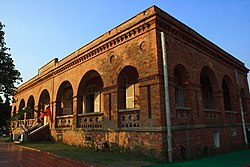Former British Consulate at Takao
This article needs additional citations for verification. (April 2013) |
| Former British Consulate at Takao | |
|---|---|
打狗英國領事館 | |
 | |
 | |
| General information | |
| Type | Former consulate |
| Location | Gushan, Kaohsiung, Taiwan |
| Coordinates | 22°37′08.0″N 120°16′00.8″E / 22.618889°N 120.266889°E |
| Completed | 1879 |
| Owner | Bureau of Cultural Affairs of Kaohsiung City Government |
| Design and construction | |
| Architecture firm | McPhail & Co |
The British Consulate at Takao (or Ta-kau;[1] Chinese: 打狗英國領事館; pinyin: Dǎgǒu Yīngguó Lǐngshìguǎn) is a former British consulate built in 1865 in Gushan District, Kaohsiung, Taiwan. It has been designated a historic site by the Ministry of Culture.[2]
It lies on the peak of Shaochuantou (哨船頭) and overlooks Sizihwan Bay and the Port of Kaohsiung.[3] It currently serves as a cafe and tourist attraction.
History
[edit]
In 1860 the Treaty of Peking forced the Qing dynasty to open up the ports of Takau (now called Kaohsiung), An-ping (Anping, Tainan), Tamsui (Tamsui, New Taipei) and Keelung to foreign trade. As the largest empire of the time, Britain was one of the first western countries to establish a consulate, appointing Robert Swinhoe as the first British vice-consul in 1861, although he was unable to physically obtain the post until 1862. Initially the consulate was centered in Tamsui, but in 1864 the office was moved to Takau.
The building itself was built in 1879 by McPhail & Co overlooking Takao Harbor and the materials were brought over from the city of Amoy (Xiamen) on mainland China. It was rented by the British Government in 1867. In the same year Swinhoe was appointed as the first Consul General in Formosa, a post he would hold until his retirement from government service in 1873.
Following the First Sino-Japanese War, the 1895 Treaty of Shimonoseki ceded the island of Formosa (as well as the Pescadores) to the Empire of Japan. Although the Treaty prompted the Triple Intervention by Russia, Germany, and France it appears to have had little effect on Britain, and thus no major events took place at the consulate at this time. In 1909, however, the Japanese government of Taiwan claimed the right to all foreign consulates in Taiwan and the British consulate was closed the next year. In 1931 the building was converted into an "Ocean Observatory" by the Japanese viceroy.
Although the walls of the consulate were painted with white cement in 1944 to avoid U.S. bombing attacks, the building saw very little action during the Second World War and does not appear to have been used for any important purpose. It was converted again to a Weather Bureau Observatory in 1945, shortly before Taiwan was handed over to Republic of China; it remained in this state for the next forty-one years.
In 1986 the Kaohsiung municipal government commissioned Li Chien Lang to restore the former consulate as a museum in which to store historic documents and cultural products; it was declared to be a Second Class Historic Site the next year. In 2003 the building was placed under the responsibility of the newly created Cultural Bureau of Kaohsiung, which appointed the Kingship Continental Hotel Group to finish the restoration and manage the building. An opening ceremony was held in September.
In 2005 the former consulate was the first-place recipient of the prestigious Yuan-Yeh Award and recorded over 400 000 visitors. In 2006 it was the site of over one hundred artistic and cultural activities, including the National Oil Painting Competition and National Photography Competition. In 2007 it was visited by the United Nations Observatory Group as well as leaders and representatives of members of the Democratic Pacific Union and the restoration of 312 oil paintings in the former consulate and surrounding area was completed.
The building
[edit]The consulate was designed by a British architect and built by McPhail & Co. in 1865 using Chinese architects. The materials were shipped over from the city of Amoy (now Xiamen) across the Taiwan Strait. The architecture is that of the late Renaissance, providing a technical and stylistic basis for later Western buildings in Taiwan, and makes use of many arches. There are two floors.
Transportation
[edit]The building is accessible within walking distance West from Sizihwan Station of the Kaohsiung MRT.
See also
[edit]References
[edit]- ^ http://britishconsulate.khcc.gov.tw
- ^ Spencer, David (9 March 2018). "Taiwan's top views". Taiwan News. Retrieved 12 March 2018.
- ^ "kaohsiungwalking.kcg.gov.tw". Archived from the original on 2007-08-14. Retrieved 2008-04-07.
External links
[edit]- Official Site Archived 2008-09-14 at the Wayback Machine (English)
- kaohsiungwalking.kcg.gov.tw
- http://www.takaoclub.com/consulate/index.htm
